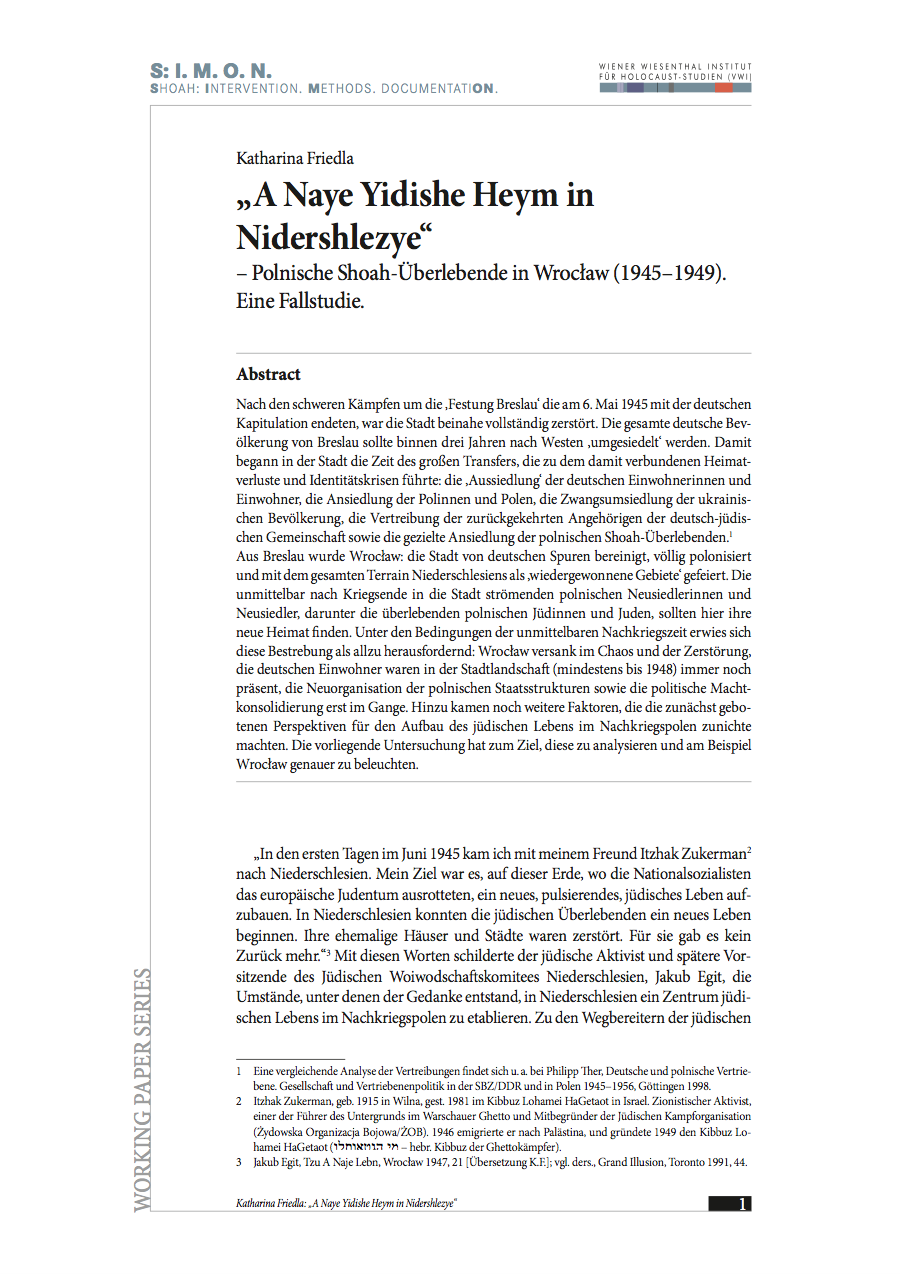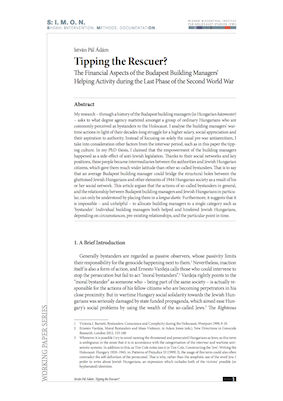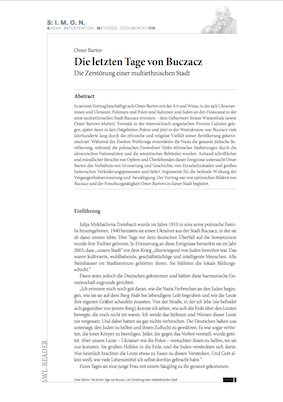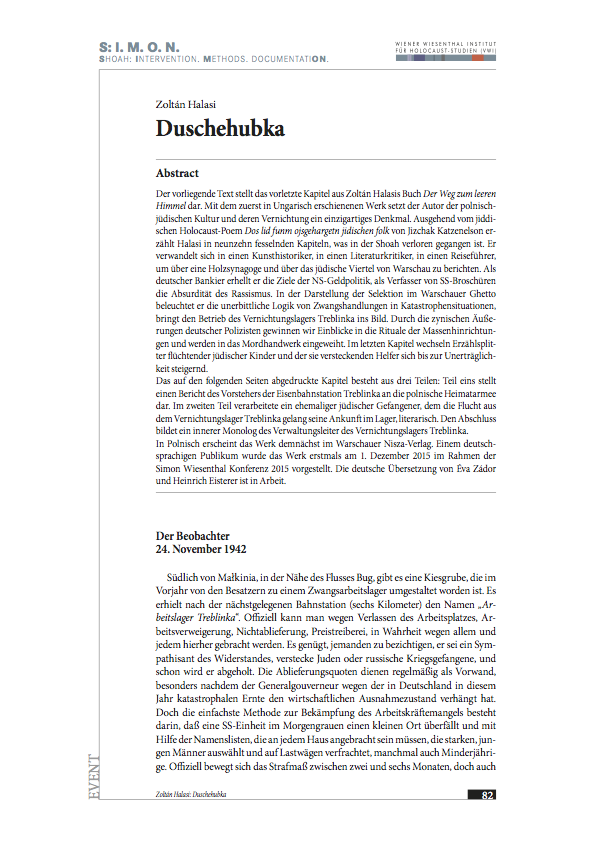 Heavy fighting around 'fortress Breslau' resulted in the German surrender on May 6, 1945 and almost completely destroyed the city. The following three years saw the 'relocation' of the city's entire German population to the West. It was the beginning of the city's great transfer period, which inevitably caused the losses of homes and identity crises: it included the ‚resettlement‘ of the German inhabitants, the settlement of Poles, the forced resettlement of the Ukrainian population, the expulsion of the returned members of the German-Jewish community as well as the directed settlement of Polish Shoah survivors. Breslau became Wrocław: the city was rid of German traces, utterly Polonized and, together with the entire area of Lower Silesia, celebrated as a „recovered territory“. The Polish settlers who surged into the city immediately after the end of the war, including Polish Jewish survivors, were supposed to find a new home there. This proved to be too great a challenge under the circumstances of the immediate post-war era: Wrocław was immersed in chaos and destruction, the presence of its German inhabitants was still apparent throughout the city (at least until 1948), the reorganization of the Polish state structures as well as the political consolidation of power was only just underway. Moreover, other factors also contributed to the demolition of initial prospects that Jewish life would be established in post-war Poland. This contribution aimed to analyse and illuminate these factors at hand of the example of Wrocław.
Heavy fighting around 'fortress Breslau' resulted in the German surrender on May 6, 1945 and almost completely destroyed the city. The following three years saw the 'relocation' of the city's entire German population to the West. It was the beginning of the city's great transfer period, which inevitably caused the losses of homes and identity crises: it included the ‚resettlement‘ of the German inhabitants, the settlement of Poles, the forced resettlement of the Ukrainian population, the expulsion of the returned members of the German-Jewish community as well as the directed settlement of Polish Shoah survivors. Breslau became Wrocław: the city was rid of German traces, utterly Polonized and, together with the entire area of Lower Silesia, celebrated as a „recovered territory“. The Polish settlers who surged into the city immediately after the end of the war, including Polish Jewish survivors, were supposed to find a new home there. This proved to be too great a challenge under the circumstances of the immediate post-war era: Wrocław was immersed in chaos and destruction, the presence of its German inhabitants was still apparent throughout the city (at least until 1948), the reorganization of the Polish state structures as well as the political consolidation of power was only just underway. Moreover, other factors also contributed to the demolition of initial prospects that Jewish life would be established in post-war Poland. This contribution aimed to analyse and illuminate these factors at hand of the example of Wrocław.
Editorial
 S:I.M.O.N. is an e-journal of the Vienna Wiesenthal Institute for Holocaust Studies (VWI). It appears twice a year in English and German language. S:I.M.O.N. aims at both a transnational and comparative history of the Holocaust and Jewish Studies in Central and Eastern Europe within the broader contexts of the European history of the 20th and 21st century, including its prehistory, consequences and legacies as well as the history of memory.
S:I.M.O.N. is an e-journal of the Vienna Wiesenthal Institute for Holocaust Studies (VWI). It appears twice a year in English and German language. S:I.M.O.N. aims at both a transnational and comparative history of the Holocaust and Jewish Studies in Central and Eastern Europe within the broader contexts of the European history of the 20th and 21st century, including its prehistory, consequences and legacies as well as the history of memory.
S:I.M.O.N. serves as a forum for discussion of various methodological approaches. The journal especially wishes to strengthen the exchange between researchers from different scientific communities and to integrate both the Jewish history and the history of the Holocaust into the different “national” narratives. It also lays a special emphasis on memory studies and the analysis of politics of memory. S:I.M.O.N. uses a double-blind review system, which means that both the reviewer’s and the author’s identities are concealed from each other hroughout the review process.
Shoah: The journal deals with the history of the Shoah from multidisciplinary, transnational and comparative perspectives. It seeks to integrate studies on Jews as well as on other groups of victims of the Holocaust, especially on Roma, and of so far less researched regions of (East) Central and (South) Eastern Europe.
Intervention. The journal reports on research projects and their transmission into public events. It also informs about current educational and remembrance programs.
Methods. The journal serves as a forum for the discussion of methodological approaches as, for instance, the everyday history, oral history, gender history, the history of violence, anti-Semitism and racism and the theory of memory and memory politics.
DocumentatiON. The journal contributes to critical approaches on using and interpreting archival materials in the 21st century.
Download the current issue S:I.M.O.N. 2017/2.
Articles
Istvan Pal Adam
Tipping the Rescuer? The Financial Aspects of the Budapest Building Managers’ Helping Activity during the Last Phase of the Second World War
 My research – through a history of the Budapest building managers (in Hungarian házmester) – asks to what degree agency mattered amongst a group of ordinary Hungarians who are commonly perceived as bystanders to the Holocaust. I analyse the building managers’ wartime actions in light of their decades-long struggle for a higher salary, social appreciation and their aspiration to authority. Instead of focusing on solely the usual pre-war antisemitism, I take into consideration other factors from the interwar period, such as in this paper the tipping culture. In my PhD thesis, I claimed that the empowerment of the building managers happened as a side-effect of anti-Jewish legislation. Thanks to their social networks and key positions, these people became intermediaries between the authorities and Jewish Hungarian citizens, which gave them much wider latitude than other so-called bystanders. That is to say that an average Budapest building manager could bridge the structural holes between the ghettoised Jewish Hungarians and other elements of 1944 Hungarian society as a result of his or her social network. This article argues that the actions of so-called bystanders in general, and the relationship between Budapest building managers and Jewish Hungarians in particular, can only be understood by placing them in a longue durée. Furthermore, it suggests that it is impossible – and unhelpful – to allocate building managers to a single category such as ‘bystander’. Individual building managers both helped and hindered Jewish Hungarians, depending on circumstances, pre-existing relationships, and the particular point in time.
My research – through a history of the Budapest building managers (in Hungarian házmester) – asks to what degree agency mattered amongst a group of ordinary Hungarians who are commonly perceived as bystanders to the Holocaust. I analyse the building managers’ wartime actions in light of their decades-long struggle for a higher salary, social appreciation and their aspiration to authority. Instead of focusing on solely the usual pre-war antisemitism, I take into consideration other factors from the interwar period, such as in this paper the tipping culture. In my PhD thesis, I claimed that the empowerment of the building managers happened as a side-effect of anti-Jewish legislation. Thanks to their social networks and key positions, these people became intermediaries between the authorities and Jewish Hungarian citizens, which gave them much wider latitude than other so-called bystanders. That is to say that an average Budapest building manager could bridge the structural holes between the ghettoised Jewish Hungarians and other elements of 1944 Hungarian society as a result of his or her social network. This article argues that the actions of so-called bystanders in general, and the relationship between Budapest building managers and Jewish Hungarians in particular, can only be understood by placing them in a longue durée. Furthermore, it suggests that it is impossible – and unhelpful – to allocate building managers to a single category such as ‘bystander’. Individual building managers both helped and hindered Jewish Hungarians, depending on circumstances, pre-existing relationships, and the particular point in time.
SWL-Reader
 Omer Bartov's presentation addressed the way in which Ukrainians, Poles and Jews remember the Holocaust in the formerly multi-ethnic town of Buczacz, where Simon Wiesenthal was born (as was Omer Bartov's mother). Buczacz is located in what used to be the Austro-Hungarian province of Galicia, then became part of Poland's eastern lands and is now part of the Western Ukraine. For centuries, it was marked by its population's ethnic and religious diversity. During the time of the Second World War, the Nazis murdered the entire Jewish population; the Polish inhabitants fell victim to ethnic cleansing by Ukrainian nationalists and Soviet authorities. Omer Bartov used written and oral reports by victims and survivors in order to investigate the relationship between memory and history, between individual fates and grand historical processes of change. He argued for the healing effect of remembrance and coming to terms with the past. The presentation was accompanied by a wealth of pictures of Buczacz and of Omer Bartov's research activities in that city.
Omer Bartov's presentation addressed the way in which Ukrainians, Poles and Jews remember the Holocaust in the formerly multi-ethnic town of Buczacz, where Simon Wiesenthal was born (as was Omer Bartov's mother). Buczacz is located in what used to be the Austro-Hungarian province of Galicia, then became part of Poland's eastern lands and is now part of the Western Ukraine. For centuries, it was marked by its population's ethnic and religious diversity. During the time of the Second World War, the Nazis murdered the entire Jewish population; the Polish inhabitants fell victim to ethnic cleansing by Ukrainian nationalists and Soviet authorities. Omer Bartov used written and oral reports by victims and survivors in order to investigate the relationship between memory and history, between individual fates and grand historical processes of change. He argued for the healing effect of remembrance and coming to terms with the past. The presentation was accompanied by a wealth of pictures of Buczacz and of Omer Bartov's research activities in that city.
Events
Zoltán Halasi
Duschehubka
 This text is the penultimate chapter of Zoltán Halasi's book Út az üres éghez (Road to an Empty Sky). With this work, which was first published in Hungarian, the author created a singular memorial to Polish-Jewish culture and its destruction. Setting out from the Yiddish Holocaust poem Dos lid funm ojsgehargetn jidischen folk by Itzhak Katzenelson, Halasi records what was lost in the Shoah in the course of nineteen compelling chapters. He takes on the grab of an art historian, a literary critic and a travel guide when he reports about a wooden synagogue and the Jewish quarter in Warsaw. In the role of a German banker, he illuminates the aims of the Nazi monetary policies, as a writer of SS brochures he highlights the absurdity of racism. Depicting a Selektion in the Warsaw ghetto, he shows the grim logic of compulsive acts in catastrophic situations, draws an image of the running of the extermination camp Treblinka. The cynical words of two German policemen provide an insight into the rituals of mass executions and introduce us to the craft of murder. The final chapter is an interplay of slithers of narrative by Jewish children on the run and by those who helped and hid them that borders on the unbearable.
This text is the penultimate chapter of Zoltán Halasi's book Út az üres éghez (Road to an Empty Sky). With this work, which was first published in Hungarian, the author created a singular memorial to Polish-Jewish culture and its destruction. Setting out from the Yiddish Holocaust poem Dos lid funm ojsgehargetn jidischen folk by Itzhak Katzenelson, Halasi records what was lost in the Shoah in the course of nineteen compelling chapters. He takes on the grab of an art historian, a literary critic and a travel guide when he reports about a wooden synagogue and the Jewish quarter in Warsaw. In the role of a German banker, he illuminates the aims of the Nazi monetary policies, as a writer of SS brochures he highlights the absurdity of racism. Depicting a Selektion in the Warsaw ghetto, he shows the grim logic of compulsive acts in catastrophic situations, draws an image of the running of the extermination camp Treblinka. The cynical words of two German policemen provide an insight into the rituals of mass executions and introduce us to the craft of murder. The final chapter is an interplay of slithers of narrative by Jewish children on the run and by those who helped and hid them that borders on the unbearable.
The chapter reproduced on the following pages has three parts: Part one is a Treblinka railway station master's report to the Polish Home Army. In the second part, a former Jewish detainee who managed to escape from the extermination camp Treblinka gives a literary treatment of his arrival at the camp. The final part consists of an inner monologue by the Treblinka extermination camp's director of administration.
The book will shortly be published in Polish at the Nisza publishing company in Warsaw. The German-speaking public was first presented with the work on December 1, 2015 at the Simon Wiesenthal Conference 2015. The German translation by Éva Zádor and Heinrich Eisterer is in progress.
Katharina Friedla: „A Naye Yidishe Heym in Nidershlezye“. Polnische Shoah-Überlebende in Wrocław (1945-1949). Eine Fallstudie
„... zu lesen, wenn alles vorüber ist“
Rita Maria Rockenbauer, Briefe 1938 –1942
Wien 2014
Partituren der Erinnerung.
Der Holocaust in der Musik
Scores of Commemoration.
The Holocaust in Music
Wien 2015
Before the Holocaust Had Its Name. Early Confrontations of the Nazi Mass Murder of the Jews
Wien 2016
Akademisches Milieu, Juden und Antisemitismus an den Universitäten Europas zwischen 1918 und 1939
Academic Milieu, Jews and Antisemitism at European Universities between 1918 and 1939
Wien 2016






